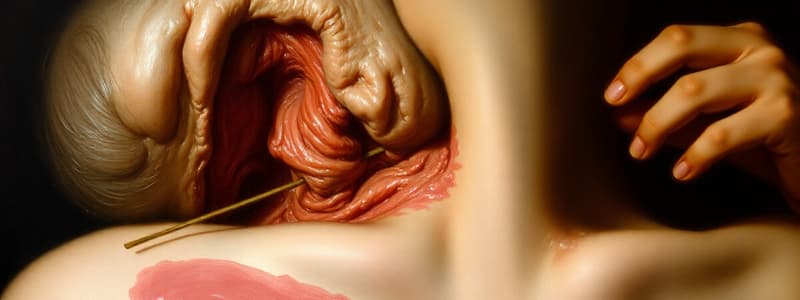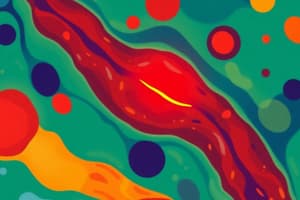Podcast
Questions and Answers
Which of the following mechanisms contributes most significantly to the formation of hypertrophic scars?
Which of the following mechanisms contributes most significantly to the formation of hypertrophic scars?
- Unregulated apoptosis of fibroblasts within the wound margin.
- Loss of extracellular matrix integrity, preventing normal collagen remodeling.
- Overproduction of collagen, leading to deposits extending beyond the original wound boundaries. (correct)
- The activity of myofibroblasts causing contraction within the original wound margin.
In second intention wound healing, what role do myofibroblasts play, and how does this affect the resulting scar tissue?
In second intention wound healing, what role do myofibroblasts play, and how does this affect the resulting scar tissue?
- Myofibroblasts promote angiogenesis, resulting in increased blood supply to the healing tissue and reduced scar formation.
- Myofibroblasts stimulate the deposition of collagen type III, resulting in a more flexible and less dense scar.
- Myofibroblasts facilitate wound contraction, leading to a smaller but potentially thicker and more fibrotic scar. (correct)
- Myofibroblasts inhibit collagen synthesis, leading to a weaker, more elastic scar.
A patient develops a chronic venous leg ulcer. Which pathophysiological process is most directly responsible for the impaired healing in this type of ulcer?
A patient develops a chronic venous leg ulcer. Which pathophysiological process is most directly responsible for the impaired healing in this type of ulcer?
- Prolonged pressure on bony prominences, leading to tissue necrosis and ulceration.
- Bacterial infection, which inhibits fibroblast proliferation and collagen synthesis.
- Reduced arterial blood flow, leading to ischemia and impaired oxygen delivery to the wound.
- Increased hydrostatic pressure due to incompetent venous valves, causing edema and tissue breakdown. (correct)
What is the primary distinction between healing by first intention and healing by second intention regarding the role of epithelial regeneration?
What is the primary distinction between healing by first intention and healing by second intention regarding the role of epithelial regeneration?
How does transforming growth factor beta (TGF-$\beta$) influence the remodeling phase of wound healing, and what is its net effect on scar formation?
How does transforming growth factor beta (TGF-$\beta$) influence the remodeling phase of wound healing, and what is its net effect on scar formation?
If a patient has loss of structural framework, what is the most likely pathway that will occur?
If a patient has loss of structural framework, what is the most likely pathway that will occur?
Compared to hypertrophic scars, what histological characteristic is most diagnostic for keloids?
Compared to hypertrophic scars, what histological characteristic is most diagnostic for keloids?
What is the primary reason arterial ulcers are more painful when the affected limb is elevated, as opposed to venous ulcers?
What is the primary reason arterial ulcers are more painful when the affected limb is elevated, as opposed to venous ulcers?
What is the central difference in the pathophysiology of venous and arterial ulcers that dictates differing treatment strategies?
What is the central difference in the pathophysiology of venous and arterial ulcers that dictates differing treatment strategies?
An individual is recovering from a severe burn that damaged the deep dermis, and the resulting wound is healing with significant contraction, leading to limited joint mobility. Which of the following factors is most directly responsible for this outcome?
An individual is recovering from a severe burn that damaged the deep dermis, and the resulting wound is healing with significant contraction, leading to limited joint mobility. Which of the following factors is most directly responsible for this outcome?
Flashcards
Healing by First Intention
Healing by First Intention
Occurs in clean, sutured wounds, edges brought together for faster healing, resulting in a thin, linear scar.
Healing by Second Intention
Healing by Second Intention
Occurs in severe, deep wounds where edges cannot be closed, healing from the bottom up, resulting in a large, fibrotic scar.
Granulation Tissue
Granulation Tissue
Tissue composed of thin-walled blood vessels, fibroblasts, macrophages, loose connective tissue, and edema fluid, forming within the first week of injury.
Hypertrophic Scar
Hypertrophic Scar
Signup and view all the flashcards
Keloid
Keloid
Signup and view all the flashcards
Wound Contracture
Wound Contracture
Signup and view all the flashcards
Venous Leg Ulcers
Venous Leg Ulcers
Signup and view all the flashcards
Arterial Ulcers
Arterial Ulcers
Signup and view all the flashcards
Pressure Sores
Pressure Sores
Signup and view all the flashcards
Trichrome Stain
Trichrome Stain
Signup and view all the flashcards
Study Notes
- Skin wound healing and tissue repair are examined
Phases of Repair
- Tissue injury starts with hemostasis and inflammation
- The regenerative phase involves cell proliferation, connective tissue and granulation tissue formation, and angiogenesis
- Remodeling includes collagen type III removal by macrophages, replaced by collagen type I deposition
Healing by First Intention
- Typically happens to cleaned, uninfected wounds like surgical incisions closed with sutures
- Wound edges are brought together for faster healing from the inside and out
- The injury phase involves blood clot formation and inflammation
- Neutrophils arrive within 1-2 days
- Macrophages clean up debris and secrete growth factors
- A thin scar comprising of granulation tissue forms in the regenerative phase
- Cell proliferation closes the gap
- Minimal remodeling occurs
- Results in a thin, linear scar that heals quickly
Healing by Second Intention
- Occurs in severe or deep wounds where edges cannot be approximated like decubitus ulcers, diabetic ulcers, or large abrasions
- Healing occurs from the bottom up
- Phases are similar to first intention but more extensive
- Angiogenesis and cell proliferation occur in the regenerative phase
- Granulation tissue is produced, leading to a thick, fibrous scar
- Transforming growth factor (TGF)-β stimulates collagen deposition
- Process takes four to six weeks to progress to a strong scar
- Myofibroblasts contract the wound to enhance closure
- Results in a larger, more fibrotic scar with a longer healing time
Granulation Tissue Formation
- Forms within the first week after injury
- Thin-walled blood vessels (angiogenesis) occur
- Fibroblasts and macrophages are present
- There is loose connective tissue, specifically collagen type III
- Edema fluid (increased extracellular fluid) is present
- Collagen type III is replaced by collagen type I for a stronger scar
- Trichrome stain highlights collagen deposition in blue
- Over time, epithelial cells regenerate over the scar
Hypertrophic Scars
- Raised but remains within wound margins
- Common in thermal burns and deep dermal injuries
- Contains myofibroblasts, giving it contractile properties
- Regresses over months
Keloids
- Excessive collagen deposition forms an exuberant growth
- Extends beyond wound boundaries
- More common in individuals with darker skin
- Does not regress and often recurs after removal
- Histologically, it is characterized by thick, irregular collagen bundles in the deep dermis
Wound Contractures
- Exaggerated contraction of the wound leads to deformities
- Common in severe burns and cases of excessive fibrosis
- Myofibroblasts drive contraction, restricting movement
Chronic wound defects
- Conditions that lead to chronic wounds, which fail to progress through the healing process
Venous Leg Ulcers
- Result from chronic venous insufficiency (CVI), causing venous hypertension and blood pooling in the lower extremities
- Incompetent venous valves increase hydrostatic pressure
- Leads to edema, inflammation, and tissue breakdown
- Mainly appears on the medial malleolus
- Shallow, irregularly shaped, surrounded by hyperpigmented skin
- It's is associated with edema, dermatitis, and varicose veins
- Impaired venous return leads to tissue hypoxia and chronic inflammation
- Increased matrix metalloproteinases (MMPs) degrade extracellular matrix
- Prevents proper healing
Arterial Ulcers
- Result from peripheral arterial disease (PAD) due to atherosclerosis
- Reduced arterial perfusion leads to ischemia and necrosis
- Located on pressure points, toes, heels, and lateral malleolus
- Punched-out appearance with sharp borders
- Minimal exudate and very painful, especially with elevation
- Surrounding skin is cool, pale, hairless, and shiny due to poor circulation
- Decreased oxygen and nutrient supply impairs fibroblast function and collagen synthesis
- Low growth factor availability prevents angiogenesis and tissue regeneration
Pressure Sores (Decubitus Ulcers)
- Prolonged pressure on bony prominences (sacrum, heels, ischial tuberosities)
- Leads to ischemia, necrosis, and ulceration
- Common in immobilized or bed-bound patients
- Stages include non-blanching erythema, superficial skin loss, full-thickness skin loss, and exposed bone, muscle, or tendon
- Prolonged compression reduces capillary flow and causes tissue hypoxia and necrosis
- Moisture and friction exacerbate damage found in incontinent patients
Healing Pathways
- Regeneration leads to resolution if the extracellular matrix (ECM) remains intact
- Fibrosis and scarring occur if the structural framework is lost
Granulation Tissue Components
- Angiogenesis, fibroblasts, and collagen synthesis
- Replacement of type III collagen with type I via TGF-β occurs
Studying That Suits You
Use AI to generate personalized quizzes and flashcards to suit your learning preferences.




